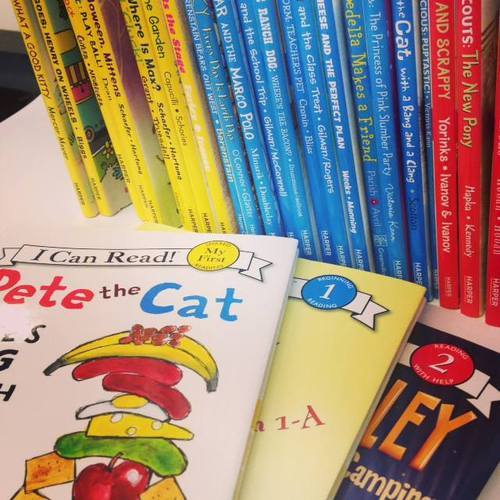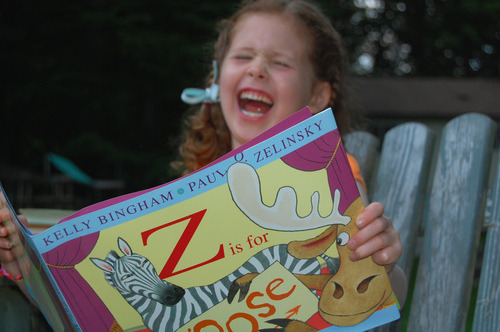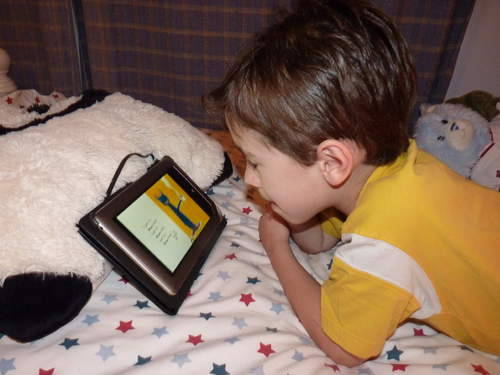By Sandie Angulo Chen
Half of all American adults admit to never having read a single book since graduation from high school and most of the rest admit to reading only one book a year.[1]
1. Read to your kid daily. A 2011 international study[2] found that fourth graders whose families had often engaged in “early literacy activities” such as reading books and telling stories scored 18 percent higher on reading tests compared to students whose families never or almost never did. So, give your kids a head start to reinforce the happy connection between family and books.

2. Give them ownership of what books to check out. Induct your children into the society of readers by getting them their own library cards. Celebrate the event, and after they’ve become card-carrying readers, let them select their own books to take home and read. For birthdays and holidays, give your children special books, alongside or instead of another toy.
3. Encourage, don’t disparage. Once your child begins to read, take turns reading to each other, and practice patience with your reader. Wait until the end of the page before helping with a word, so he’s not discouraged from trying. If a child is struggling, read the page to him and then have him read it back. Don’t spoil the warm feelings of a family read-along with excessive pressure and corrections. Instead, act like a reading buddy who’s there to offer help and encouragement.

4. Let the words – and emotions – flow off the page. Encourage kids to make an emotional connection with their books by inviting them to talk about the story. For younger children, discuss what the characters are like and predict what might happen next. Encourage older children to explore the ideas and feelings that their book has engendered in journals, artwork, or by recommending it to friends. By asking for children’s opinions and listening to them without judgment or criticism, they also learn that you value their feelings and respect their judgment.

5. Just keep reading. Extensive research shows that the best way to become a better reader is to simply read more, and that these periods of “sustained silent reading” or “drop everything and read” work best when students are given regular opportunities to read, a variety of classroom materials are available, teachers read silently with their students, and students are allowed to share what they had read.[3] Set aside 20 minutes a day for reading where there’s no book reports, no chapter quizzes, and vocabulary tests afterwards. If a book doesn’t hold its appeal after a few chapters, find another one.
6. Find the right reading material. According to a 2006 survey,[4] the No. 1 reason kids don’t read more is because they can’t find books they like to read. To help readers overcome this barrier, make students a deal when it comes to recreational reading: in exchange for reading for a set time, tell kids they can read anything they want: sports magazines, video game tutorials, newspapers, comic books, or joke collections. Let their English teacher worry about the classics. The goal here is for kids to practice reading with anything that makes them excited to read.
7. Delve into a compelling series. Book series are perennially successful tools at getting reluctant readers hooked on reading. Because a series makes it obvious what to read next, it encourages students to make reading a continuous habit, instead of a casual, once-in-a-while endeavor. Then, when your child is on the last book of a series, turn to a librarian, bookseller or teacher for suggestions for the next multiple-book franchise to start.

8. Ratify the Reader’s Bill of Rights. Nine out of 10 kids age 6–17 say they are more likely to finish a book they choose themselves.[5] In her book The Book Whisperer,English teacher and literacy advocate Donalyn Miller encourages reading for pleasure and practice by reminding readers of their “reader’s rights:”
● “You have the right to abandon books you don’t like.” Reading for pleasure should come with the freedom to abandon a book that hasn’t drawn them in by chapter four.
● “You have the right to skip sentences or paragraphs in novels.” For readers in middle school and up, it’s okay to skip some sentences or paragraphs. Since they won’t be tested, they won’t be penalized by skimming over less compelling characters or scenes. So long as they still retain an understanding of the book, having fun is more important than going over every word.
● “You can adjust your reading speed if you want to.” While textbooks demand slow, careful reading to ensure full comprehension, novels can be read at a faster speed. Memorization isn’t the goal – fun is.
9. Encourage boys’ literary lives. According to the U.S. Department of Education, boys have scored lower than girls in reading tests for decades.[6] Only 39 percent of boys say reading books for fun is extremely or very important compared to 62 percent of girls.[7] Remind boys that nonfiction, humor books, comics, graphic novels, action-adventure, magazines, websites, and audiobooks all count as reading. Look to online resources dedicated to encouraging boys to read, such as guysread.com, a website that lists books by categories such as “Robots,” “How to Build Stuff,” “Outer Space, but with Aliens,” and “At Least One Explosion.”

10. Don’t give up on struggling readers. Not everyone learns to love reading early on, and some children struggle with it. For these reluctant or struggling readers, ask a librarian for “high/low” books that include a compelling storyline but less challenging language. Let these readers’ outside interests guide reading choices, and refrain from judging or shaming them for their reading selections. Consider reading aloud a first chapter to pique interest, and remind them that they can pick another book if they’re not hooked by chapter two.
Sources:
Guysread.com, a website that helps get boys interested in reading by recommending books in categories.
Readkiddoread.com, a pro-literacy website established by best-selling author James Patterson that includes age-appropriate book recommendations.
Readingrockets.com, a website established by public television station WETA that helps young children, their parents, and educators teach lifelong reading skills.
James Patterson, “How to get your kid to be a fanatic reader,” CNN.com published Sept. 28, 2011, athttp://www.cnn.com/2011/09/28/opinion/patterson-kids-reading/.
Reading is Fundamental, “Children Who Can Read, But Don’t…,” athttp://www.rif.org/us/literacy-resources/articles/children-who-can-read-but-dont.htm.
Lori Rog and Paul Kropp, “Hooking Struggling Readers: Using Books They Can and Want to Read” athttp://www.readingrockets.org/article/374/.
Donalyn Miller, “Share a Story Shape a Future: Creating a Reading Culture at Home” The Book Whisperer Blog, Education Week Teacher, published May 5, 2012, athttp://blogs.edweek.org/teachers/book_whisperer/2012/03/share_a_story_shape_a_future_c.html.
Rachel Cicure, “10 Ways to Make Reading Fun!,” Oprah.com, published Aug. 8, 2008, at http://www.oprah.com/oprahsbookclub/_74/1.
“Book Time Is Together Time,” Parent and Child Magazine, athttp://www.scholastic.com/parents/resources/article/reading-together/book-time-together-time.
“Bad Books Make Good Reading,” Parent and Child Magazine, athttp://www.scholastic.com/parents/resources/article/book-selection-tips/bad-books-make-good-reading.
The National Institute of Education, Becoming a Nation of Readers: The Report of the Commission on Reading (1984).
[1] Woiwode, L. (1992). Television: The cyclops that eats books. Imprimis, 21 (2), 1; Morrow, L. M. (1992). The impact of a literature-based program on literacy achievement, use of literature, and attitudes of children from minority backgrounds. Reading Research Quarterly, 27, 250-275.
[2] PIRLS 2011 International Results in Reading, conducted by the TIMSS & PIRLS International Study Center at Boston College, available at http://timssandpirls.bc.edu/pirls2011/international-results-pirls.html.
[3] McKool, S.S., "Factors that influence the decision to read: an investigation of fifth grade students’ out-of-school reading habits,” Reading Improvement (Sept. 22, 2007).
[4] 2006 Kids and Family Reading Report, conducted by Scholastic, Inc. and Yankelovich, available at http://www.scholastic.com/aboutscholastic/news/reading_survey_press_call_2.pdf
[5] 2012 Kids and Family Reading Report, conducted by Scholastic, Inc. and Harrison Group, available at http://mediaroom.scholastic.com/files/kfrr2013-wappendix.pdf.
[6] 2013 Grades 4 and 8 mathematics and reading assessments conducted by the National Assessment of Educational Progress (NAEP), available at http://nationsreportcard.gov/reading_math_2013/#/achievement-gaps
[7] 2012 Kids and Family Reading Report, conducted by Scholastic, Inc. and Harrison Group, available at http://mediaroom.scholastic.com/files/kfrr2013-wappendix.pdf.
Notes:
 lemmebeyourpornstar liked this
lemmebeyourpornstar liked this heybundtcakes-blog reblogged this from harpercollinschildrens
heybundtcakes-blog liked this
keepgoingmimosa reblogged this from harpercollinschildrens
sleeping-with-dem0ns-blog reblogged this from harpercollinschildrens
 kainsmommy810 reblogged this from driftzombee
kainsmommy810 reblogged this from driftzombee bluesman88 reblogged this from harpercollinschildrens
exslothsted reblogged this from harpercollinschildrens
driftzombee reblogged this from harpercollinschildrens
diamonds-gold-and-weed liked this
 hope-chest-wedding-blog-blog reblogged this from harpercollinschildrens
hope-chest-wedding-blog-blog reblogged this from harpercollinschildrens freckledaze liked this
jessmikhail liked this
waterobsessed liked this
keepwhispersunsaid liked this
littlekid-in-chalkzone-blog reblogged this from harpercollinschildrens
lincolnlibraryri reblogged this from harpercollinschildrens
itgoesding liked this
way-too-many-books reblogged this from harpercollinschildrens
way-too-many-books liked this
susanat16 liked this
yesgoplay reblogged this from harpercollinschildrens
thedomesticthornberrys liked this
 leahwilliamsveazey liked this
leahwilliamsveazey liked this a-reason-to-hold-on reblogged this from harpercollinschildrens
a-reason-to-hold-on liked this
100percentperfectgirl liked this
thefelicitoussmoak liked this
cparsles liked this
ladyfabulous liked this
geekinlibrariansclothing reblogged this from harpercollinschildrens and added:
I would change boys/guys to child’s engaging to read I see a dramatic drop in love for reading in all school kids, but I...
geekinlibrariansclothing liked this
phoebs097 liked this
davenportlib liked this
mm8443 liked this
inbedwithbooks liked this
staaarfish liked this
royalfireworkspress liked this
allmyexofeels liked this
harpercollinschildrens posted this
- Show more notes


